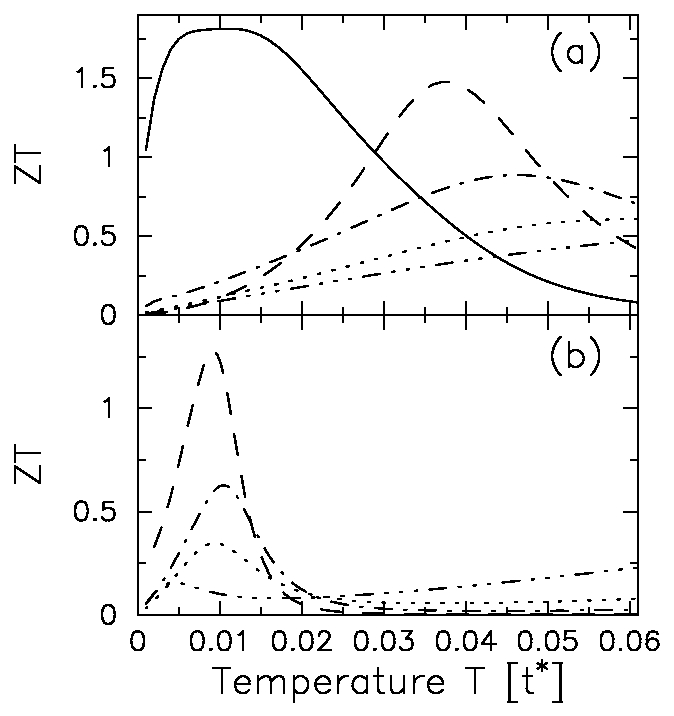Thermal transport
In this project, we are using computational physics to explore possibilities
for low-temperature thermo-electric coolers. We wish to investigate
devices constructed out of heavy Fermion materials with one sign of
the thermopower and either Mott or Kondo insulators with the other
sign of the thermopower. Since these systems often have large peaks in the
thermopower at low temperature (the Kondo scale), they are good candidates for
low-temperature operation. Experimental systems are being devised and grown
by Frank Steglich's laboratory at the Max Planck Institute for the Physics
and Chemistry of Solids. We intend to ultimately investigate nanostructures
of these materials, but we have also investigated some interesting bulk
properties. Namely, when we find an exponentially suppressed density of
states, which creates a pseudogap feature in the insulator, then the
thermoelectric figure of merit ZT can be tuned to be larger than one at
low temperature. This effect disappears when there is a true gap, with
vanishing density of states. In a nanostructure, the density of states never
vanishes in the barrier, if the insulator is attached to metallic leads due
to a normal-state proximity effects, which has the metallic density of states
leak into the insulator. But it is not yet clear whether this situation can
give rise to a large ZT at low temperature. In one final note, we need to
say that our calculations are for the electronic part of the device only.
Often, phonon thermal conductivity can dramatically lower ZT, especially at
low temperature, since it rises linearly with T and the electronic contribution
may rise exponentially and T, so that the phonons dominate at low
temperature and sharply reduce ZT.
Annotated list of publications
Bulk thermal transport

- J. K. Freericks and V. Zlatic',
Nonlinear Peltier effect and the nonequilibrium Jonson-Mahan theorem,
Cond. Matter Phys. 9, 603--617 (2006).
- A. V. Joura, D. O. Demchenko, and
J. K. Freericks,
Thermal transport in the Falicov-Kimball model on a Bethe lattice,
Phys. Rev. B 69, 165105--1-5 (2004).
-
J. K. Freericks,
D. Demchenko, A. Joura,
and V. Zlatic',
Optimizing thermal transport in the Falicov-Kimball model: binary-alloy
picture, Phys. Rev. B 68, 195120--1-12 (2003).
Here we examine what happens to thermal transport properties in the
Falicov-Kimball model. We examine thermal transport in a particle-hole
asymmetric Mott transition on a Beth and hypercubic lattice with
dynamical mean field theory. We find
regions where the thermoelectric figure of merit is
larger than one both at low temperature and high temperature. But it
is possible the low temperature peaks will disappear when phonon thermal
conductivity is included. We also find quite different behavior on the
hypercubic lattice versus the Bethe lattice which is due to anomalous
features associated with the pseudogap nature of the insulating phase
on the hypercubic lattice. It may be possible to exploit this anomaly in
nanostructures, since their behavior appears to be closer to the
hypercubic lattice than the Bethe lattice. In addition, we also examine
how te peltier effect is modified when one moves into the nonlinear transport
regime.
Real materials
- V. Zlatic', R. Monnier, J. K. Freericks, and K. Becker,
Relationship between the thermopower and entropy of strongly correlated
electron systems, submitted to Phys. Rev. B.
- V. Zlatic', R. Monnier, and J. K. Freericks,
Thermoelectricity of
EuCu2(Ge1-xSix)2
intermetallics, (Proceedings of the Strongly Correlated Electron
Systems 2005 conference, Vienna, Austria), Physica B 378--380, 661--662
(2006).
- H. Wilhem, V. Zlatic', and D. Jaccard,
Thermoelectric power of heavy Fermion compounds,
(Proceedings of the Strongly Correlated Electron
Systems 2005 conference, Vienna, Austria), Physica B 378--380, 644-647
(2006).
- V. Zlatic' and R. Monnier,
Theory of the thermoelectricity of intermetallic compounds
with Ce or Yb ions,
Physical Review B 71, 165109--1-12 (2005).
Here an Anderson impurity model, with an NCA approach and crystal field
splitting is employed to examine the bulk thermal transport properties of
strongly correlated materials. The focus is on both heavy Fermion compounds
and intermediate valence systems. Theory presented here unifies some
experimental data that find a strong correlation between the linear
coefficient of the specific heat and the linear behavior of the thermopower
at low temperature.
Thermal transport in nanostructures
Last modified September 12, 2004.
Jim Freericks, Professor of Physics
